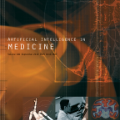The estimation of rare event probabilities plays a pivotal role in diverse fields. Our aim is to determine the probability of a hazard or system failure occurring when a quantity of interest exceeds a critical value. In our approach, the distribution of the quantity of interest is represented by an energy density, characterized by a free energy function. To efficiently estimate the free energy, a bias potential is introduced. Using concepts from energy-based models (EBM), this bias potential is optimized such that the corresponding probability density function approximates a pre-defined distribution targeting the failure region of interest. Given the optimal bias potential, the free energy function and the rare event probability of interest can be determined. The approach is applicable not just in traditional rare event settings where the variable upon which the quantity of interest relies has a known distribution, but also in inversion settings where the variable follows a posterior distribution. By combining the EBM approach with a Stein discrepancy-based stopping criterion, we aim for a balanced accuracy-efficiency trade-off. Furthermore, we explore both parametric and non-parametric approaches for the bias potential, with the latter eliminating the need for choosing a particular parameterization, but depending strongly on the accuracy of the kernel density estimate used in the optimization process. Through three illustrative test cases encompassing both traditional and inversion settings, we show that the proposed EBM approach, when properly configured, (i) allows stable and efficient estimation of rare event probabilities and (ii) compares favorably against subset sampling approaches.
翻译:暂无翻译


